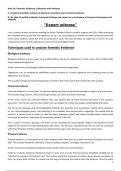Unit 23: Forensic Evidence, Collection and Analysis
C: Conduct scientific analysis of physical, biological and chemical evidence
D: Be able to justify methods, interpret findings and report on conclusions of forensic techniques and
analysis
“Expert witness”
I am a trainee forensic technician working for British Transport Police’s scientific support unit (SSU). After processing
the simulated crime scene that my supervisor set up, I am now required to analyse and draw conclusions from the
crime scene evidence which will then be presented in court. This task will allow my supervisor to see if I am now
competent to move into the laboratory to carry out live investigative work.
Techniques used to analyse forensic evidence
Biological evidence
Biological evidence is a term given to any DNA evidence left by an individual at a crime scene. This includes bodily
fluids, blood and fingerprints.
At the crime scene, the biological evidence that was present were fingerprints.
Fingerprints can be analysed by identifying certain minutiae in a latent fingerprint and comparing them to the
fingerprints of a suspect.
This is useful in forensics because fingerprints can help to link crime scenes that involve the same suspect.
Chemical evidence
Chemical evidence is a term given to chemical substances that may be found on people or objects at a crime scene.
This includes drugs, poison, firearm discharge residue, soil, fibres and other chemicals.
At the crime scene, the chemical evidence that was present was ink from the pens that were in the suspect’s
possession. This ink was used to write a letter that was located on a table near a glass contaminated with saliva.
Pen ink can be analysed using chromatography methods, this would be done by placing a sample of the substance
on the chromatography paper and attaching it to a wooden stick secured with a paperclip. This would then be
placed in a solvent (such as water) so that the paper (stationary phase) and solvent (mobile phase) interact with
each other to produce a separation of components present in the ink.
This is useful in forensics because a Rf factor can be calculated by measuring the height of the baseline and the
height of the solvent line then dividing these two values. The Rf factor calculated from this can then be compared
with other Rf factors of other substances to determine the type of pen that was used at the crime scene.
Physical evidence
Physical evidence is a term given to all other evidence items that does not contain chemicals and does not contain
DNA. This includes footprints, toolmarks, firearms, bullets, weapons, cartridges, documents, etc.
At the crime scene, the physical evidence present at the crime scene was footprints.
Evidence of plastic footprints (footprints found in sand, mud or snow [Forensic Science Simplified, 2013b]) can be
collected by creating a 3D footprint cast. This involves using flour and water to create a paste, known as a plaster of
Paris, by mixing both of these in a plastic zip-lock bag and pouring the mixture onto the footprint. Once the paste
1
, Unit 23: Forensic Evidence, Collection and Analysis
C: Conduct scientific analysis of physical, biological and chemical evidence
D: Be able to justify methods, interpret findings and report on conclusions of forensic techniques and
analysis
has dried, the cast is then removed and must be photographed to maintain the continuity of evidence. 2D prints of
shoes that potential suspects were wearing are then created after this. These are made by applying paint to the
base of the shoe and carefully placed on paper. The 3D cast is compared side by side to the 2D prints to see if any
particular grooves or marks are similar to each other.
This is useful in forensics because it can help CSIs to work out what shoes the suspect may have been wearing when
committing the crime, so that they can be linked to the crime as well as any other crimes that they have committed.
Analysis of biological evidence
Fingerprints were taken of three potential suspects: suspect 1, suspect 2 and suspect 3. These prints were then
compared to the fingerprints found at the crime scene.
Figure 1a: Fingerprint taken of suspect 1
Figure 1b: Fingerprint taken of suspect 2
2




